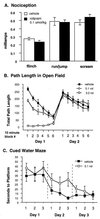Rolipram, a type IV-specific phosphodiesterase inhibitor, facilitates the establishment of long-lasting long-term potentiation and improves memory
- PMID: 9844008
- PMCID: PMC24568
- DOI: 10.1073/pnas.95.25.15020
Rolipram, a type IV-specific phosphodiesterase inhibitor, facilitates the establishment of long-lasting long-term potentiation and improves memory
Abstract
In an attempt to improve behavioral memory, we devised a strategy to amplify the signal-to-noise ratio of the cAMP pathway, which plays a central role in hippocampal synaptic plasticity and behavioral memory. Multiple high-frequency trains of electrical stimulation induce long-lasting long-term potentiation, a form of synaptic strengthening in hippocampus that is greater in both magnitude and persistence than the short-lasting long-term potentiation generated by a single tetanic train. Studies using pharmacological inhibitors and genetic manipulations have shown that this difference in response depends on the activity of cAMP-dependent protein kinase A. Genetic studies have also indicated that protein kinase A and one of its target transcription factors, cAMP response element binding protein, are important in memory in vivo. These findings suggested that amplification of signals through the cAMP pathway might lower the threshold for generating long-lasting long-term potentiation and increase behavioral memory. We therefore examined the biochemical, physiological, and behavioral effects in mice of partial inhibition of a hippocampal cAMP phosphodiesterase. Concentrations of a type IV-specific phosphodiesterase inhibitor, rolipram, which had no significant effect on basal cAMP concentration, increased the cAMP response of hippocampal slices to stimulation with forskolin and induced persistent long-term potentiation in CA1 after a single tetanic train. In both young and aged mice, rolipram treatment before training increased long- but not short-term retention in freezing to context, a hippocampus-dependent memory task.
Figures




References
-
- Goelet P, Castellucci V F, Schacher S, Kandel E R. Nature (London) 1986;322:419–422. - PubMed
-
- Davis R L. Phys Rev. 1996;76:299–317. - PubMed
-
- Huang Y Y, Nguyen P V, Abel T, Kandel E R. Learn Mem. 1996;3:74–85. - PubMed
-
- Johnston D, Williams S, Jaffe D, Gray R. Annu Rev Physiol. 1992;54:489–505. - PubMed
-
- Weiskopf M G, Casrillo P E, Zaluzky R A, Nicoll R A. Science. 1994;265:1878–1882. - PubMed
Publication types
MeSH terms
Substances
LinkOut - more resources
Full Text Sources
Other Literature Sources
Medical
Miscellaneous

